In November 2015, Majestic Software released their Dash 8 Q400 Pro Edition, an extension to their highly acclaimed Q400 Pilot’s Edition. In this review, I’ll be taking a look at the entire product, not just the features that differentiate the Pro Edition from the Pilot’s Edition. So let’s go, shall we?
The Bombardier Dash 8 Q400 is a 78-passenger, twin turboprop airliner. Introduced in 1999, it is the latest and largest in a family started by De Havilland Canada 1983. The Q400, the ‘Q’ standing for ‘Quiet’, differentiates itself from its competitors by its high performance. Often called ‘jet like’, the Q400’s speed allows it to more effectively compete with regional jets on short-haul routes.
It was announced long before release that the Majestic Software Dash 8 Q400 would eventually be available in 3 versions: Pilot, Pro and Training, with increasing features, complexity, but also price over the versions. Visuals (both interior and exterior), flight dynamics, sounds and many of the systems are almost identical between versions. For an overview of the differentiation features, I’ll refer to the table on the Majestic Software website or product pages.
The Majestic Software Dash 8 Q400 Pilot’s Edition was met with rave reviews when it was released amid high anticipation by the community. But I opted to wait for the Pro version before I tackled it.
Installation:
As an extended version to an already very high-end product, it shouldn’t surprise any that the Q400 Pro version is quite expensive. The price for the Pro version is €74,95 (give or take a bit due to tax rates or exchange rates). For Simmarket customers, take careful note of the version you buy. There’s an EU version, and an international version. They are identical, but both exist due to EU tax laws. Customers of the Q400 Pilot Edition can upgrade for just the price difference between versions, a very nice gesture by Majestic Software.
As for system requirements, any PC that is capable of running FSX or P3D should do according to Majestic. The Q400 works in FSX SP2 or Acceleration, FSX Steam Edition, Prepar3D v2.5 or Prepar3D v3. One purchase goes with all sims, which I really like. Majestic chose the customer friendly option here. I really don’t care for paying (sometimes a lot) extra just to use the exact same software in a slightly different simulator platform.
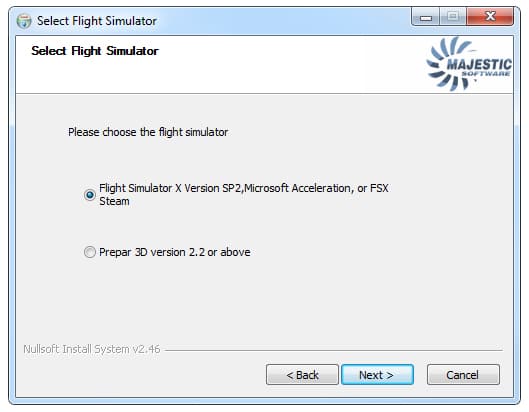
After purchase, you get access to the download. For version 1.018 this comes in at 509MB. I would advise anyone to also check the Majestic Software website for the latest patches. At the time of my review, this was version 1.018c, a 50MB download.
Installation was easy and trouble free for me. It does need an internet connection though. The installer checks your order number and email address against a database to check whether you’re a legitimate customer. I was able to activate the product as soon as the installer was finished downloading, so no problems there for me.
Once installed, the Q400 Pro takes up a little over 2.3GB on your hard drive. For this, you get the aircraft with all its related files, documentation, Control and Systems Panels, an EGPWS database, and no less than 20 liveries, ranging from Air Baltic on one end of the alphabet, to Wideroe on the other.
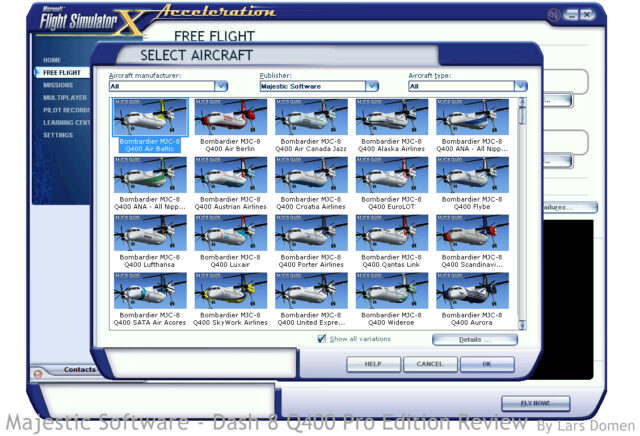
Exterior:
With its pointy nose, long but narrow fuselage, large T-tail, high aspect-ratio straight wings and massive propellers, the Q400 has a distinct visual appearance. As is to be expected, this general appearance is well represented in the simulated version. The modelling looks very good, and appears accurate. From the general shape to the small details, great model.
I also like the animations on that 3D model. They’re smooth and appear accurate to me. I’m particularly fond of those big, 6-bladed propellers. Even with the engines off, they are affected by the airflow. So quite often, you’ll see them spinning slowly when parked, due to the wind. The start-up animation is particularly smooth, with those big props slowly spinning up. The switch from visible blades to a ‘propeller disk’ happens quite late in the start-up process, something I quite like. Many FS turboprops look like they go from a standstill to spinning full speed in no time at all. Not so the Majestic Q400.
Nice to see as well, is that even when the propellers are represented as a semi-transparent disk in the sim, propeller pitch changes are still visible, as the disk gets thicker and thinner. Very nice!
The textures are also good-looking. They’re sharp and detailed. Personally, I think a bit more wear and tear is possible. But looking at online pictures, most Q400’s appear to be kept quite clean. So it doesn’t feel like it’s a flaw in the product. Anyway, it’s not like the Majestic Q400 is lacking in detail, feels fake or looks flat. In contrary! It’s a product that lends itself well for taking screenshots.
The aircraft also looks good at night, with very nice lighting. The lighting is strong and very present, but looks believable. Landing and taxi lights also light up the scenery nicely.
Interior:
The quality visible on the outside model continues inside. Very detailed, very good looking. The quality remains good all throughout the virtual cockpit, even in less obvious areas. For example, all circuit breaker panels (and there are quite a lot of those) are modelled in 3D, and animated! (Although, due to FS limitation, actually using them is done with 2D panels)
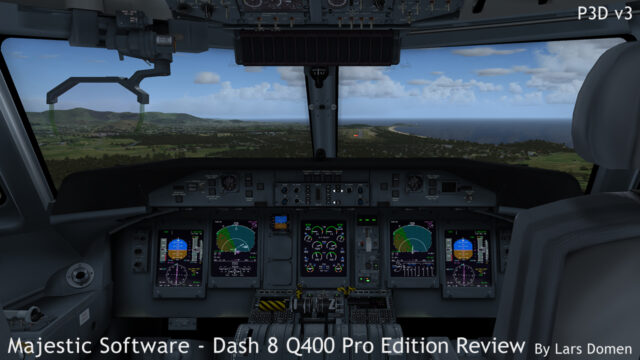
The textures in the VC are also of high quality. They are sharp and readable all over. There’s also a nice amount of wear, tear, grime and dust to be found. It’s a workplace after all. But, for those who don’t really like this, rest assured, it’s not filthy, just used. I particularly like the subtle specs of dust on the displays. I’m not so fond of the texturing on the handles of the engine levers. There’s paint chipped off, clearly showing lots of use, yet they remain equally shiny all over. It just doesn’t add up in my mind. But I’m really nitpicking at this point. The general experience is well and truly positive.
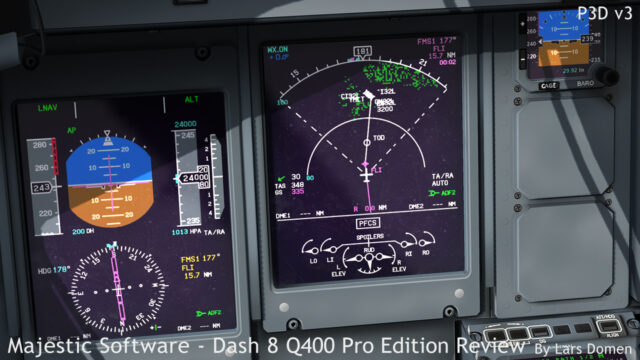
At night, the Q400’s VC tends to be quite dark in my experience, although this may also be explained by my use of P3Dv3 as the main sim for testing (which is noticeably darker at night than FSX) and the relatively low brightness setting of my display. That being said, the lighting in the VC is equal in quality to all other visual aspects of this product. I particularly like the dimmable panel backlighting. It looks great, and transitions smoothly from dim to bright, without noticeable jumps in brightness.
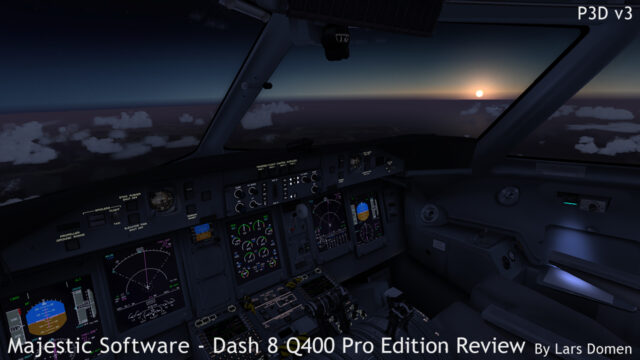
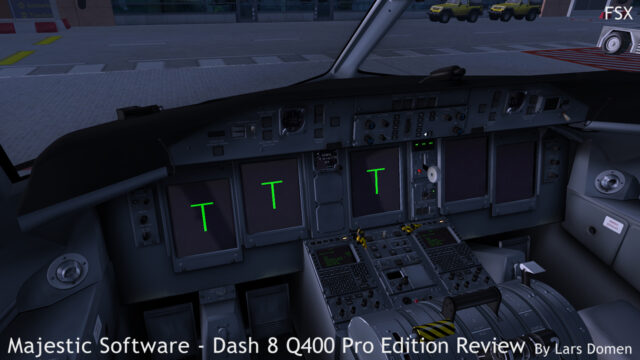
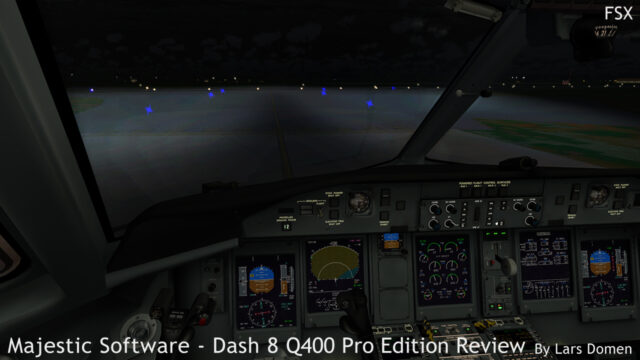
Sound:
Sounds in the Q400 are of good quality. From engine noise (or should I say propeller noise?) to clicks in the virtual cockpit. It’s there, and sounding good.
While the soundset is basically the same in the Pro edition as in the Pilot edition, there is a big difference: the system fully supports a 7.1 sound setup, and lets you manually assign sound categories to specific speakers. By default, all sounds are handled dynamically in 3D, except for the captain’s and FO’s headphones, which are assigned to the left and right front speakers respectively.
I saw no need to touch this on my modest 2.1 sound setup. But if you’re running a high-end sound system, or a sim cockpit with dedicated speakers, this feature in the control panel allows you to get the Q400 sounding just like you want it to.
Flight Dynamics:
Probably the most advertised, and even hyped by fans, feature of the Majestic Q400 is the custom flight dynamics modelling. Reportedly, the Q400 uses the popular open source JSBsim Flight Dynamics Engine (FDE).
Whatever it uses, and however they do it, in the end, it’s how it flies that matters. Of course, I have no experience as a pilot in the real aircraft. Never been a passenger in one either. But generally, the flight dynamics feel realistic and believable.
The aircraft feels quick and nimble at low altitude, yet remains very controllable at speeds so low they would scare any jet pilot. Response to power changes is quick and direct, much more so than compared to turbofan engines. On the other hand, you’ll also notice the climb rate becoming sluggish at relatively low altitudes. Compared to jets that is, the Dash 8 flies high and fast for a turboprop!
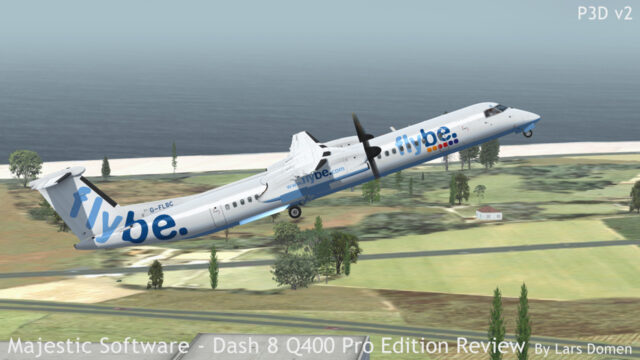
I really like hand flying the Q400. You’ll want to make sure you have your trim controls close at hand though. Flying the dash requires quite some work on the trims, and not only for the elevator! When properly trimmed, the Q400 is a joy to fly. It feels very responsive, never giving you the feeling of being ‘on rails’ or lagging behind. It really ‘feels’ like you’re in control.
Even at low speeds and high angles of attack, the aircraft’s behaviour remains believable. Stalls also appear realistic. When going past what’s reasonable though, the FDE started to break down. When keeping the aircraft in the stall, and keeping the yoke pulled back, the Q400 starts making some strange twists and turns. But then again, this is a situation you would never experience in real life, and I’ve never seen ANY simulation do well in this situation. Even multi-million dollar full-motion sims don’t simulate this situation, as no one actually knows what would happen to the real aircraft in this case. At least the aircraft didn’t start falling upwards, like some FSX aircraft tend to do when you push them past their normal envelope.
So, you can surely say I like the FDE of the Majestic Q400 in action. However, there are some issues with how it integrates with the simulator that bother me. First of all, Aerosoft AES pushback doesn’t work. The aircraft just jumps back to where the pushback began. Not the result you’d like to see, although Majestic Software told me they were working on it. GSX pushback reportedly didn’t work at first, but that was fixed long ago, and it does now. There also is a custom pushback feature available in the FMC, which works perfectly. So most bases are covered.
Another issue I noticed is that on the ground (below a certain speed), any interruption in the sim will cause the speed to drop to zero. A nuisance while taxiing, but a true deal breaker upon takeoff. I noticed this at first when I still had FSUIPC autosave turned on (which the Q400 doesn’t like at all). But the same happens when there’s a freeze in the sim, or you manually pause it. The worst example I ran into of this issue, is when I was around 50kts in the takeoff roll, and a sim-stutter later, I had to start again from 0. Literally. The runway was long enough in this case, but on a short runway, this would’ve screwed up everything.
I also noticed that when I paused the sim right before touchdown (so nose up, but with negative vertical speed) to take some screenshots, the aircraft would have positive vertical speed when I unpaused. Sceenshots taken, but landing screwed up.
In the end, a very good FDE, but one that can be picky and demanding as well. If you don’t pause the sim, don’t use AES pushback, don’t use FSUIPC autosave or don’t have freezes due to other reasons, it all runs great. There’s just a tad many “if’s” there, if you ask me.
Systems:
There’s a lot that can be said about the systems. In order to keep the length of this review reasonable though, I’m going to gloss over them, and focus on what’s special in the Pro Edition. What I will say is that the Majestic Dash 8 Q400 has very detailed system simulation. If you’re used to Boeing or Airbus, you might run into some surprises though. The logic behind some of the system is different. In the end, it’s a very rewarding experience if you get it right.
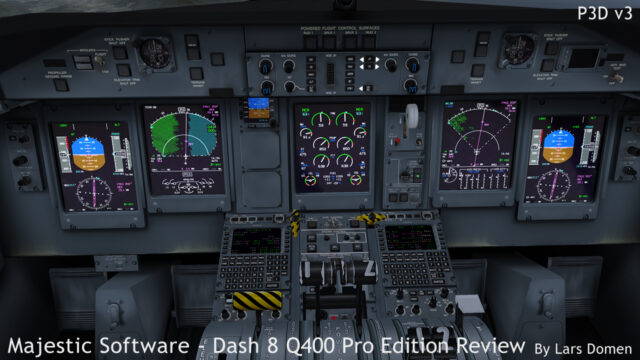
One issue that I feel compelled to mention, is that the Q400 doesn’t play well with the FSUIPC Autosave function (or similar functionality in other programs). A lot of information is saved with the Q400 (on top of the normal information the sim saves). As a result, a very noticeable 1 or 2 second ‘freeze’ or ‘stutter’ is experienced every time the sim saves. No big deal if you save manually. But if FSUIPC saves in the background every so often, it’s bothersome. The workaround is simple: disable this feature. But as this feature has saved many a flight for me, especially in vanilla FSX, I consider this a big issue.
On the other hand, saving and resuming a flight in the Q400 works outstanding. I’ve tried it several times, and it worked flawlessly every time. For such a detailed product, I consider this a great achievement, even more so because reloading the saved flight happens just about seamlessly, with no 20 second system initialization during which the aircraft just falls and stuff like that.
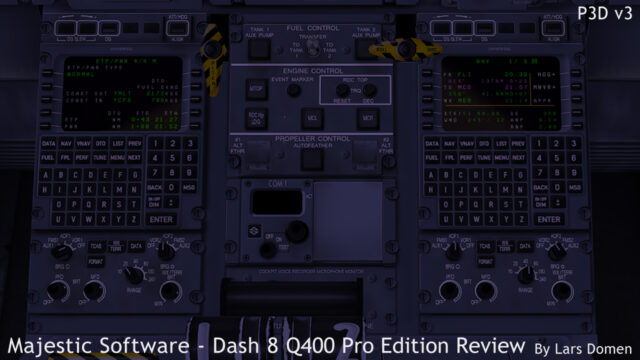
Pro-features:
So, let’s talk about features that set the Pro Edition apart from the Pilot Edition. There are several I want to mention.
2D Panels: Yes, the Majestic Dash 8 Q400 Pilot Edition has some 2D popup panels to make your virtual pilot life easier. The Pro Edition still has those popups, but also features a full range of complete 2D panels. Both captain and first officer main panels, overhead panel, centre pedestal… Everything you could want is there. They also look good, and work very well.
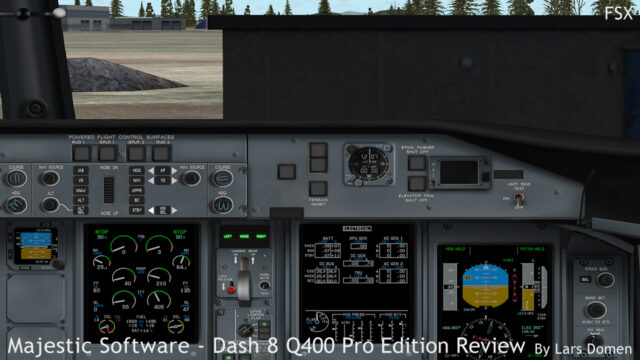
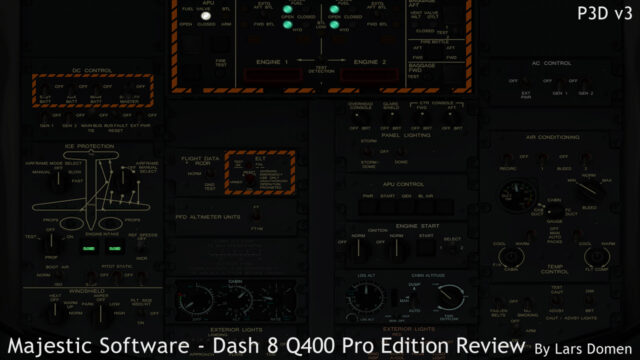
Another set of 2D panels that’s exclusive to the higher version Q400 are the circuit breaker panels. Majestic Software uses these to work around a limit in FSX and P3D: the more clickspots in the VC, the lower the performance. So instead of providing every circuit breaker with a clickspot, a 2D representation of the relevant CB panel pops up, which you use to trip or reset the circuit breakers. Note that the CB’s themselves are animated in the VC. No need to check all those 2D panels to see if any were tripped.
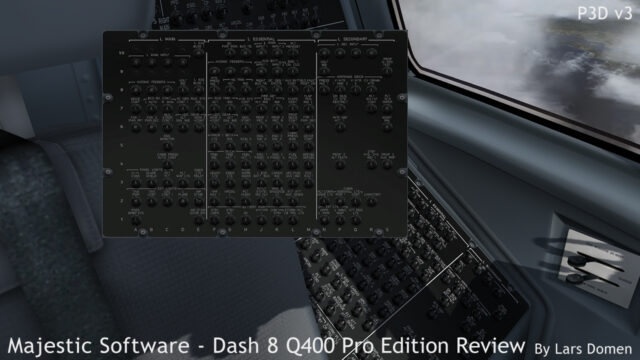
Heads Up Display: The Pro Edition also has a Heads Up Display for the captain. It looks good and works great. It’s also very well collimated to the FS world, and simulates being focussed at infinity. This means that you’ll not see anything on the HUD unless you’re sitting directly in front of it. If you prefer not to fly with the HUD, you can either just leave it stowed overhead, or use the control panel to remove it from the aircraft altogether.
Failures: The Q400 Pro features a very comprehensive failure model. However, only part of it is really easily accessible. The external Systems Panel gives you a very detailed overview of the hydraulic and electric systems, of which you can manually fail just about any part.
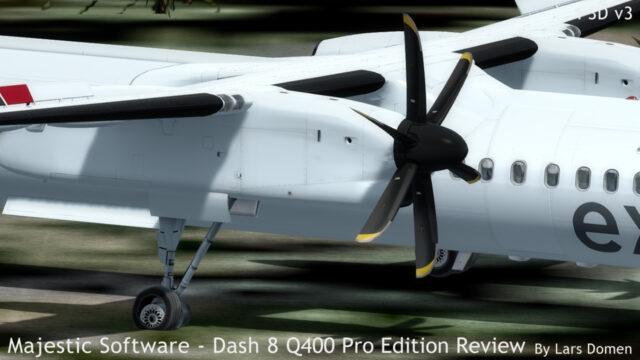
To fail other systems though, you’ll have to dive into the scripting language that comes with the Q400. It seems very powerful to use, but I haven’t gone as far as learning it all to test it.
I would’ve preferred to have a more complete systems panel, with more failures that can easily be triggered by just clicking them. I’m thinking that engines, fuel and instruments are quite interesting to fail for us desktop pilots. As I understand it, Majestic is keeping that functionality for the upcoming Q400 Training Edition.
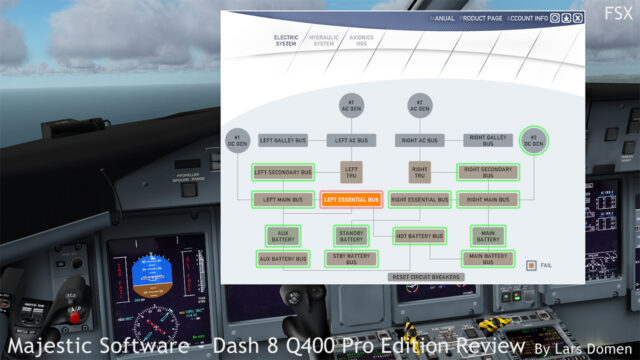
Smoother controls: With the Pro Edition, you can opt to completely bypass FSX or P3D, and let the Q400 directly read control inputs from DirectX. The big upside of this is that the sample rate is much higher (4 times higher in fact, at 125Hz or 125 samples per second). The downside is that there is no easy GUI based way of setting this up. It’s done in a text document using trial and error. It took me quite a bit of that, and a lot of reading on the forum, to finally get this feature working on my system.
The end result is definitely very pleasant, if not entirely required for a good experience. The Q400 flies very nice with “normal” controls. But it is even better with the smoother controls. The combination of a good FDE and these smoother controls, makes handflying the Q400 a joy. I just wish there was an easier and more user friendly way of setting up these controls.
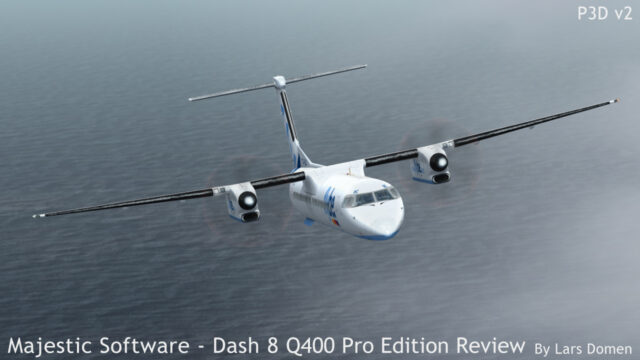
Shared Cockpit: There are more Pro Edition specific features than those I mentioned here. I’m just talking about the ones that made the biggest impression on me. And in that regard, I kept the best for last. Shared cockpit. Flying together, with 2 people, like in real life. Some would say it’s the holy grail of desktop flight simulation. The Q400 was not the first add-on to support it, and hopefully not the last either. But it’s the first time I really tried it out.
Since I wasn’t comfortable bothering some other pilot with my limited experience in the Q400, and because I really wanted to test it, not just fly, I decided to set up the shared cockpit between my own 2 pc’s. I had quite some trouble getting it to work, but I’m blaming that on firewall and network settings. I really don’t know my head around those. Once I got it working though, I was very, very impressed. I had the Q400 running on my main PC. Additionally, in ran the Q400 on my laptop, which luckily had a (previously unused) FSX Steam Edition install on it.
As soon as I got the 2 systems connected and started trying things out, I was impressed. When I flicked a switch on one PC, it would respond so quickly on the other system that the sound of it switching would overlap on both PC’s. Not entirely simultaneous, but close enough as not to matter. Switching between master and slave mode (which decides who controls the primary flight controls) also happened smoothly and instantaneously.
And to really put it to the test, I did the following: I sat myself in front of my main screen (the one connected to my main PC), but I flew the Q400 with the joystick connected to the laptop. Control was quick, smooth and predictable. In short, perfectly flyable. Even landing was no problem with this setup. If that doesn’t validated the Shared cockpit feature, I don’t know what would.
Now, the setup I ran was just about the best case scenario: 2 systems on a home network, so no lag due to internet connection hiccups or things like that. When using a connection over the internet, keep in mind that mileage may vary.
Documentation:
The first encounter you have with the documentation will likely be with the documentation index page. This is a html webpage, but stored offline on your PC, so it’ll work just fine even with no internet access. On this page are handy links to all documentation that is provided with the Q400 Pro Edition. The actual folder with these documents is located inside the SimObjects\Airplanes\mjc8q400 directory where the Q400 is installed. There are a lot of files here, namely 15 pdf-documents, the index.html page and it’s header image, and 2 folders. One with the sample flight, and one called script.
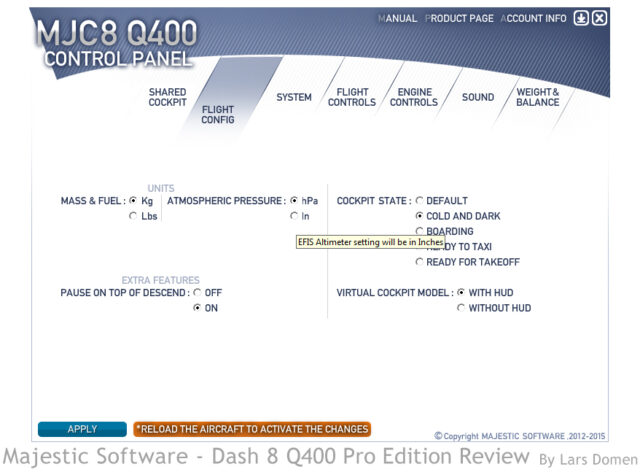
I have some mixed feelings about the documentation though. There are aspects of it I really like. Let’s start with those. I’m very fond of the fact that Majestic included both checklists and speed cards, and especially the fact that these are formatted as to be very useable and easily printable. Just as great is the fact that the speed cards are available with both metric and imperial weight units! With many FS aircraft, you have to scratch this information together yourself, and create your own printable files (or hope someone else did, and shared them). Brownie points earned Majestic!
I also really like the included sample flight. It’s a detailed explanation of a normal flight, and clearly documented with screenshots. The saved flight and weather situation are included, so no trouble with getting it set up. I learned more about actually using the Q400 with this sample flight and the second one available on the website, than from all other documentation combined.
And that brings me to the aspect I don’t like. The rest of the documentation often let me wanting. There are too many small documents that very briefly deal with one aspect of the simulation, without placing it in the wider picture of the experience as a whole. When trying to get your head around a product you’re not used to, this can be a frustrating experience. Reading online gave me the impression that I’m not the only one with these frustrations.
What I’m really missing, is a manual that gets me started, and is an easy source to go back to if I’m looking for something, even if it just points to another manual. Something like what PMDG does in their ‘Introduction’ manuals with the 737NGX or 777X, or what Aerosoft does with their ‘Vol1’ manual in their Airbus series.
If Majestic had done something like this, getting started with the Q400 would’ve been a lot less frustrating, and about half the documents they shipped with the Q400 could’ve been incorporated in this hypothetical manual.
Performance:
Unless it’s remarkably bad, I find it hard to describe how well an add-on does in the performance department. To give you an idea, all screenshots were taken at settings which result in acceptable frame rates. Acceptable for me means a minimum of 15fps in the worst case. Although I aim for higher frame rates, this is the lowest I consider usable. Information about my system and the software I run are at the bottom of this review.
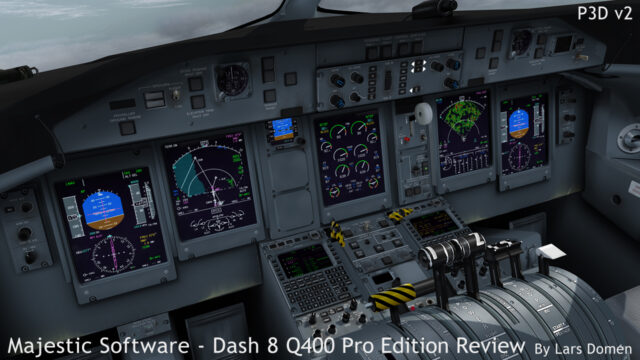
That being said, the Dash 8 Q400 is a very detailed aircraft, so it will impact performance somewhat. I never felt that it was bad though. Performance in the virtual cockpit was (for me at least) comparable or better than what I get in the PMDG NGX. The biggest hit on frame rates seemed to come from the terrain display and weather radar. With those features off or showing little activity, performance was outstanding. And even with those on, it’s not like it was bad in any way. Overall, a smooth experience in the virtual cockpit. Performance in exterior views didn’t suffer at all from the Q400.
What’s also worth noting is that the Control panel that comes with the Q400 has some options to make the VC run lighter. It’s good that these options are available, but in my experience, adjusting your FSX or P3D settings, especially in the scenery, traffic and weather sections makes a much bigger difference.
Conclusion:
I didn’t cover everything there could possibly be said about the Majestic Software Dash 8 Q400 Pro Edition. Trying to do so would result in an entire novel. However, I do hope I managed to give a good account of the product.
It took me a bit to get used to the design philosophy behind this Bombardier aircraft. Once I got my head around it though, I found myself liking it more and more every time I took it out of the virtual hangar.
More jetliner-like than other turboprops, but more turboprop-like than other jetliners, the Majestic Q400 is exactly what one expects it to be, based on its real-world counterpart. As I personally happen to like both turboprops and short-to-medium range jetliners, the Q400 feels a bit like the best of both worlds.
This is by no means a ‘get-in-and-go’ simulation. A better ‘Getting started’ manual could’ve made this aspect of the product much more enjoyable.
Once you’re past the ‘getting started’ phase though, you can enjoy a very pleasant, and very detailed add-on with loads and loads of features. There are some aspects where I consider it a bit ‘rough around the edges’. But once you got it set up just like you want, and you get comfortable with the way it works, most of these rough edges are behind you. In the end, this is a thoroughly enjoyable product. It clearly brings some of the challenges of handling the real world Q400 to the sim, and is all the more rewarding for it.
The final question to be answered is the following: should you go for the Pro Edition, or stick to the Pilot Edition. My answer is: look at the extra features in the Pro Edition compared to the Pilot Edition. If there are several you want and see yourself using regularly, or one you really can’t live without (2D panels for some, for example), go for it! The upgrade price is less than the price of some airport sceneries. If you’re new to the Q400, you can always buy the Pilot Edition, and upgrade later if you want thanks to Majestic’s generous upgrade policy!
Like:
There are lots and lots of things I like:
- Very user friendly activation and upgrade policy, and both FSX and P3D in one purchase! Many well established developers can learn from this!
- Great visuals both interior and exterior, both day and night
- Very detailed and accurate systems simulation
- Very good FDE, makes flying a joy in all situations.
- Well laid-out checklists and speed cards directly available for printing.
- Shared cockpit. Let me repeat that: shared cockpit!
- Other very advanced features in the pro version
Don’t like:
- The documentation could be a bit better, certainly considering the ‘in sim’ and ‘getting started’ topics.
- The FDE implementation has some limitations you should keep in mind.
- Not working well together with autosave functions, for example by FSUIPC.
Useful Links:
SimMarket Product Page (International)
Test System:
Intel Core i5-2500K @ 4×3.3GHz
8GB DDR3 RAM
MSI GTX 960 Gaming 2G
Windows 7 64 bit
FSX Deluxe + Acceleration
Prepar3D v2.5
Prepar3D v3.1
Software Used:
Active Sky Next
Aerosoft Bergen X
FSFX Packages PrecipitFX
Orbx FTX Australia
Orbx FTX Global
Orbx YMLT Launceston
Orbx YSCH Coffs Harbour
Real Environment Extreme Texture Direct + Soft Clouds
Ultimate Terrain X Europe v2
Voie Bleu Charleroi X


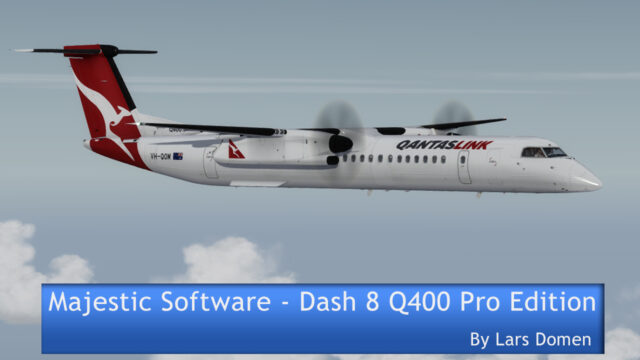
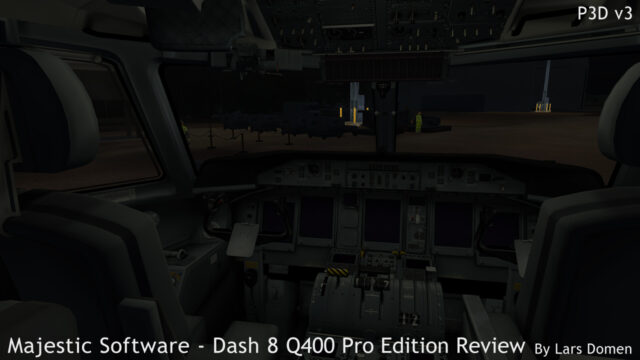
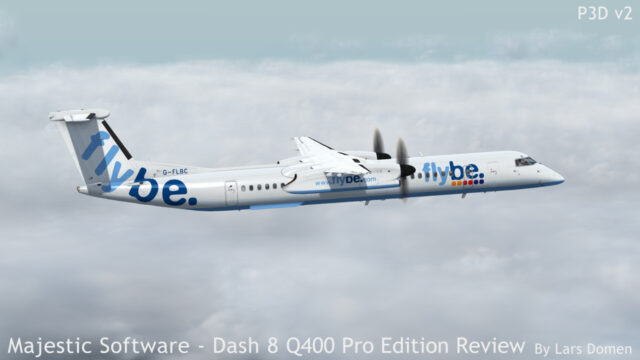
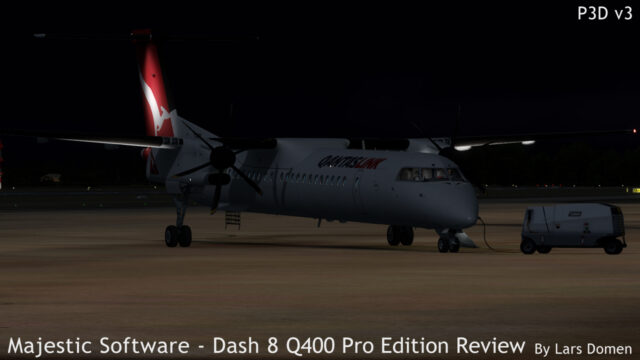
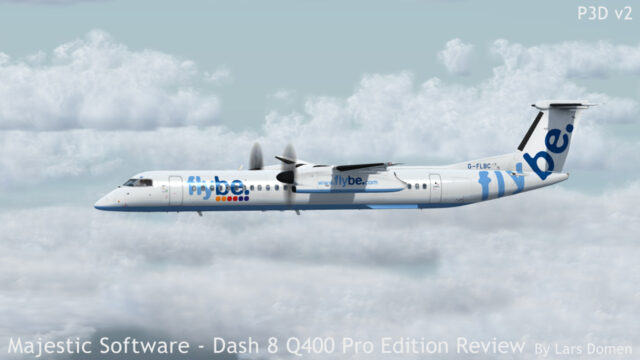
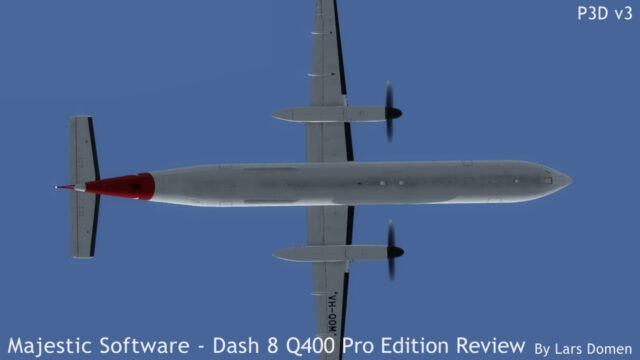
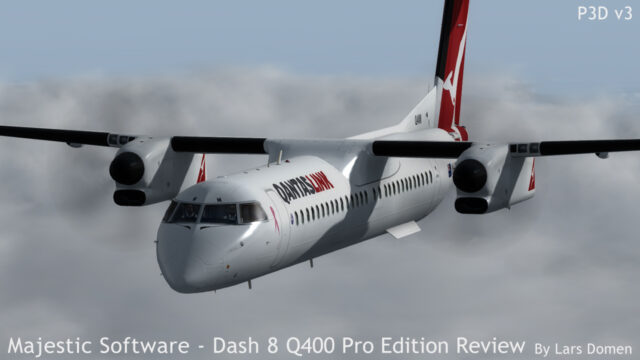
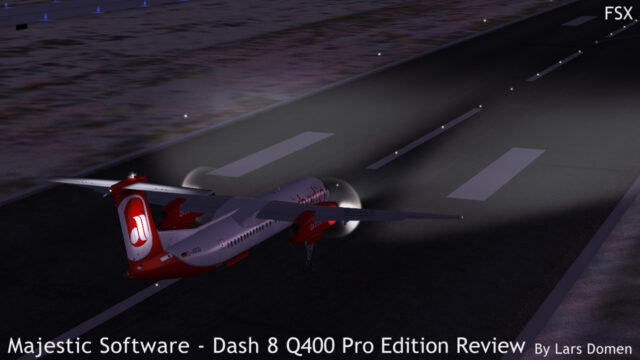
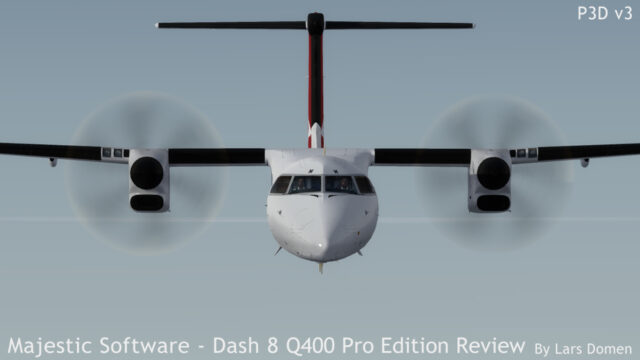
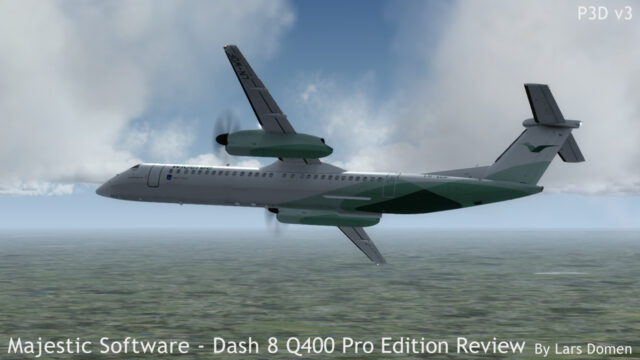
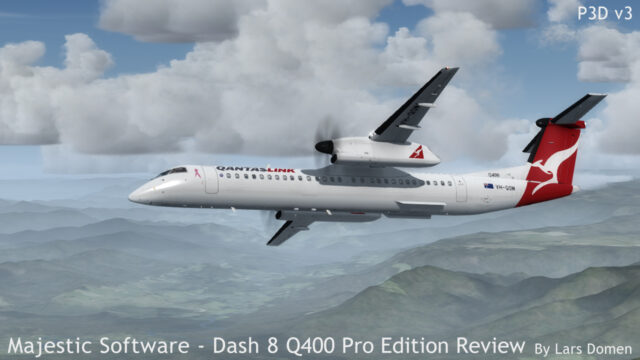
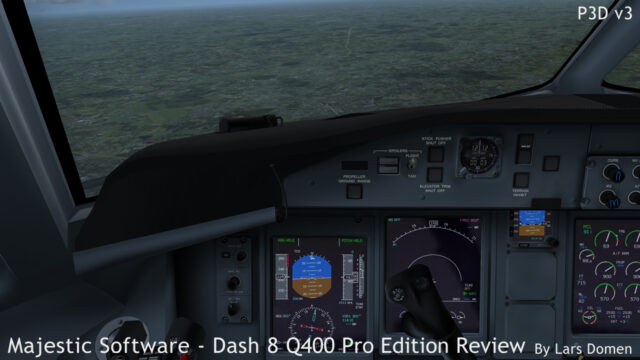
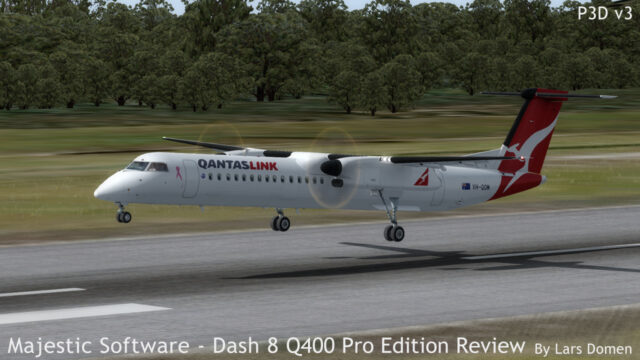
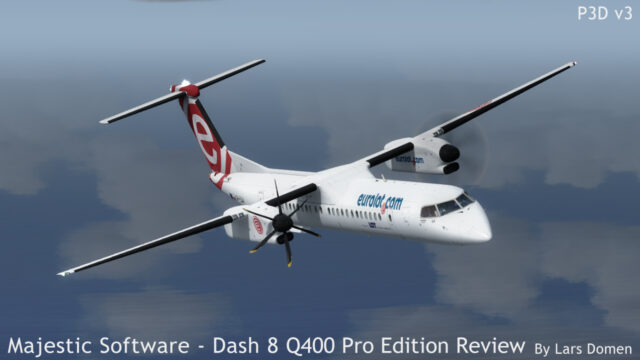
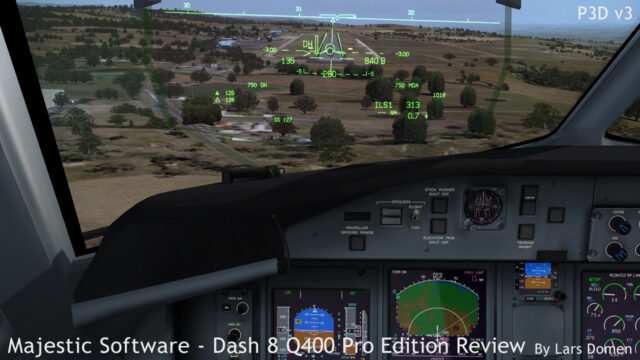
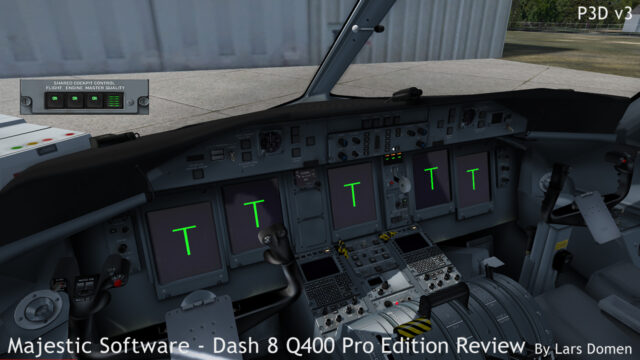
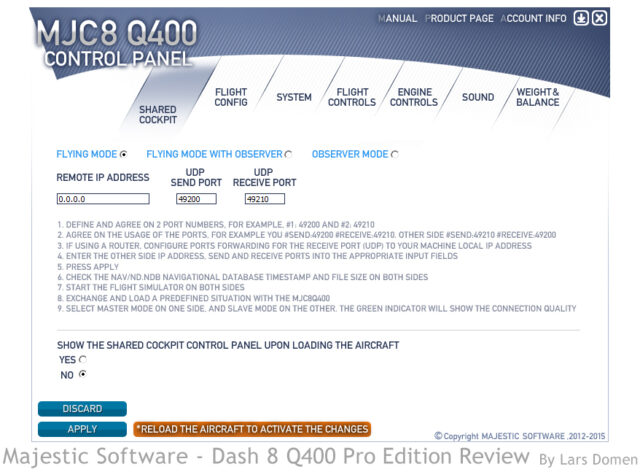
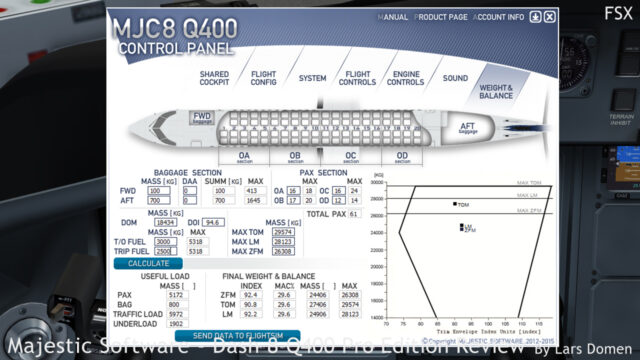
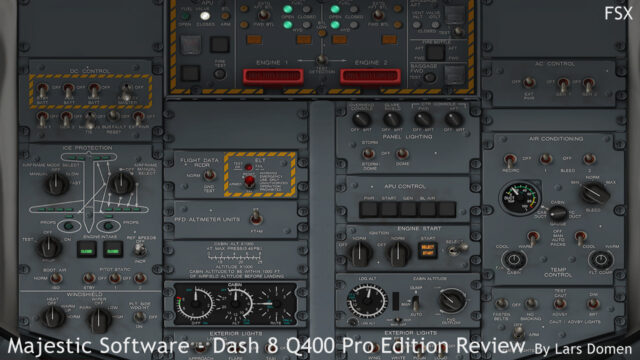
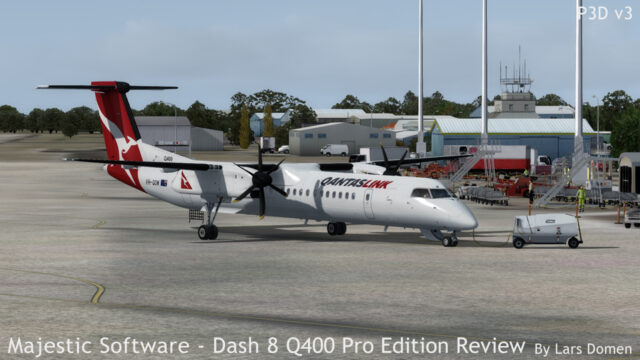
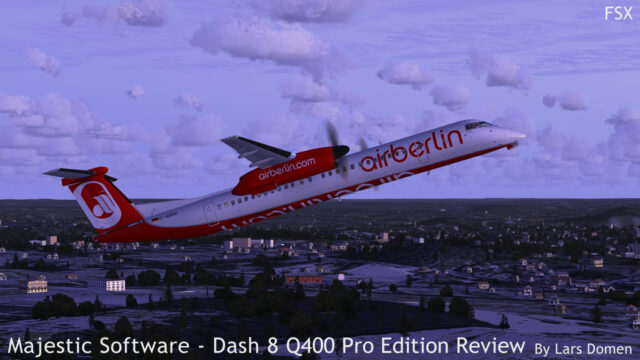
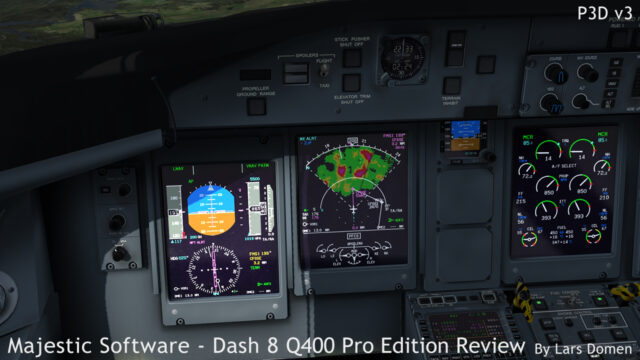
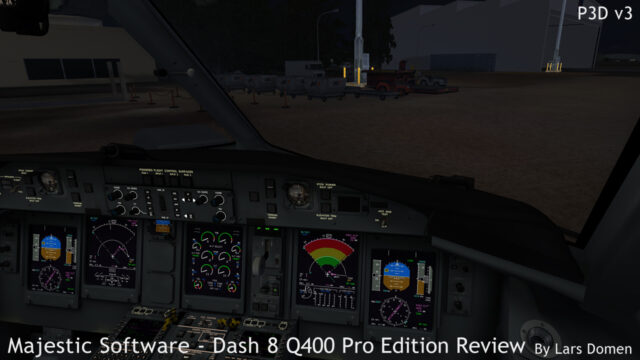
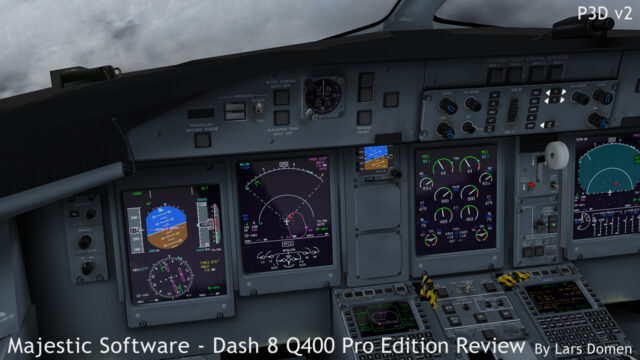
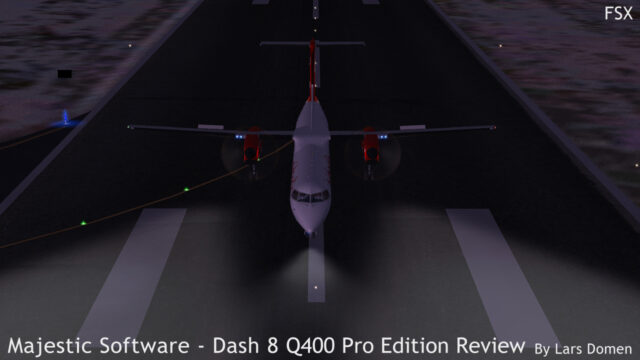
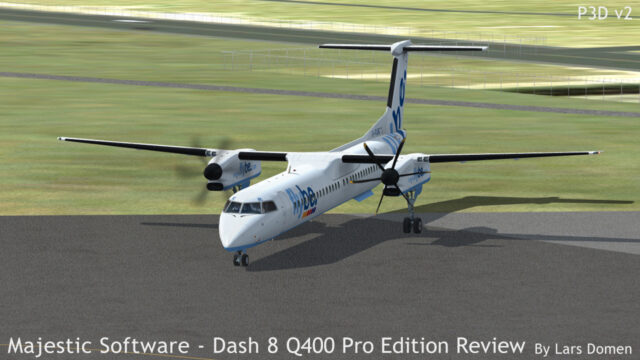
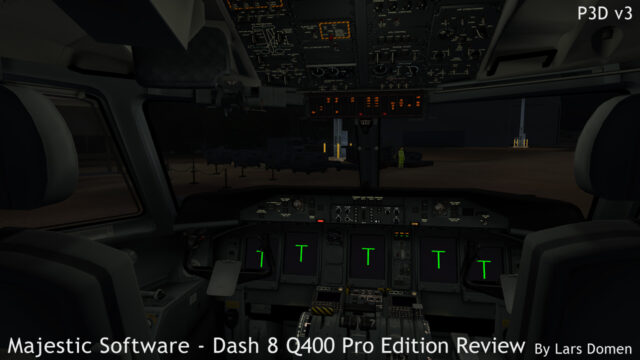
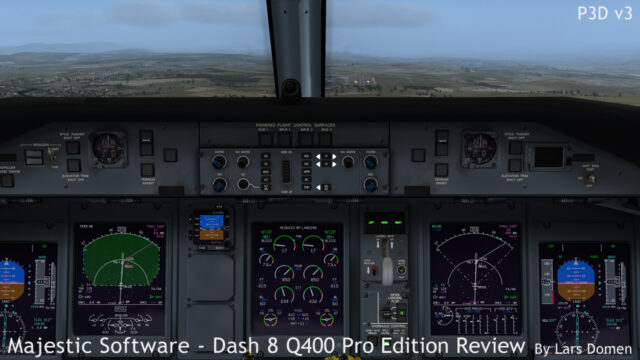
Thank You, Very good and through review.
I appreciate the discussion on flight dynamics as this is often an overlooked area of most reviews. However, your discussion of FFS is a little dated. While UPRT is very new and with FAR Part 60 the ink is not dry, there are Full Flight Simulators (FFS) that have been certified by the FAA for upset prevention recovery training (UPRT.)
http://aviationweek.com/bca/flightsafetys-upset-prevention-recovery-training-impresses
While I am unaware of any Dash-8 simulators with this capability, I suspect that as long as the manufacture has the aerodynamic data that can be programmed into the simulator, then it is just a matter of time before all aspect recovery becomes a common term with most devices.
Simulators will always never be as good as a real airplane, but when it comes to UPRT it becomes highly unlikely that crews will be purposely taking $60+million aircraft into uncharted regimes. Thus the FFS will remain the pinnacle of taking type specific training in and out of an upset.
While your statement on the capability and limitations of FFS may have been true a few years ago, things are quickly changing. While I have not specifically tried the maneuver you describe, with the capabilities of these newer devices a more predictable encounter is more likely.
The flight dynamic envelope has been greatly expanded in the FFS world.
Hey Ken,
Thank you for your feedback. The article you linked to was an interesting read indeed!
It still sounds like very new technology though…
That being said, interesting developments!
I’m sure this evolution in FFS capabilities will greatly enhance pilot training and safety.
Lars
Hi Lars,
The BEST review for the best plane!
Thank you very much, keep up the good work